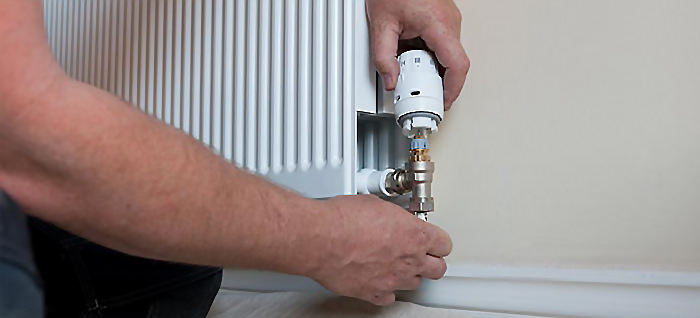How to Fit a TRV – Thermostatic Radiator Valve

A thermostatic radiator valve gives you more automation over the temperature at your home. To that, the device lowers your monthly energy bills. The fitting process is fast and simple, but there are some details you need to know to avoid damages. Follow this guide to learn an easy method on how to fit a TRV to your radiator.
What is a Thermostatic Radiator Valve?
A thermostatic radiator valve (TRV) is a device fitted to your radiator pipework that will individually control the temperature in the room by setting the heat output of the radiator it’s attached to. There are 2 main types of thermostatic radiator valve. One uses a spring that expands and contracts, and the other uses a wax jacket that does exactly the same.
What’s The Difference Between a TRV and Manual Radiator Valves?
First, a normal radiator valve is just a valve that moves up and down and shuts off the flow of hot water from the boiler into the radiator, just like the tap on a bath tap. The main difference with a TRV is that it automatically controls the amount of hot water entering a radiator based on the temperature in the room. The installation process of a manual radiator valve is similar.
How Does a TRV work?
For this example, we are going to look at the spring type TRV, but the wax jacket version is fitted similarly. So we have a metal spring that is very susceptible to the surrounding temperature. If the room is cold, the metal spring will contract. Therefore, the valve jumper opens and hot water is allowed to flow into the radiator. If the room is warm, the spring will expand pushing the valve down, and the flow to the radiator will stop.
A common problem may be a cold room. Although the radiator is blazing hot, you may still want to go to the thermostatic radiator valve and open it up more. That’s of no use because the radiator valve is still trying to heat it up. Adjust the TRV if you feel that the radiator remains cold.
Where Should I Fit a TRV?
Many thermostatic radiator valves nowadays are bidirectional, and you can install them to either the flow or the return pipe of your radiator. However, we would advise you to fit the TRV on the pipe that carries water to your inlet valve – the flow pipe. Wonder why? Well, if you mount a non-bidirectional thermostatic valve to the return pipe, you would later discover that a noisy, vibrating sound comes out of it while the water rushes through.
Also, in a property with 2 rooms, one requires a room thermostat that controls the entire heating system and a single radiator. The other room has a second radiator with a TRV attached to it. Refrain from fitting a TRV on the radiator that has the room thermostat. The two together won’t work as expected, and you won’t save enough energy.
The room thermostat needs to have an exact reading of the maximum capacity of the heating system. Therefore, the radiator which has a room thermostat should have a fully open lockshield valve. A heating engineer can survey your home and offer professional expertise on the matter.
How to Fit a TRV?
Let’s find out how you change or install a new thermostatic radiator valve in 3 steps:
1. Drain your system and let the air out
Drain down your heating system and allow air into all the radiators, where you plan to install TRV’s. Bleed your radiators with a bleed key and a hose. Once the water stops running, you are ready to remove the old valve.
2. How to remove the old valve
Pull the top cover off to reveal the simple on/off valve. Using grips and an adjustable spanner, slacken off the nut that is coming out of the radiator pipework. Once it’s loose, you can slip the pipework out to see if all the water has drained out of the system. Next, loosen off the 15mm pressure fitting on the bottom of the valve. You can then remove the whole valve from the radiator pipe.
3. Fitting the new thermostatic radiator valve
Sometimes the new TRV won’t fit on the current valve insert. They supply all new TRVs with a new insert, so you may have to remove the old one. Insert a simple hex tool into the hole and then use an adjustable spanner to loosen the part. Now wrap a PTFE around the new insert, push it into the radiator and tighten it up. The old nut and olive should be fine to use, but if you want to change those, just pull the nut off and use a pair of grips to pull the olive.
Wrap a bit of PTFE around the new olive to ensure a watertight seal. Push the fitting back in and tighten up the bottom joint. Make sure everything is tight and remove the top plastic cap of the valve. You can test if it springs up and down the right way. Put the TRV head unit on the top and adjust it. You should now have a working TRV.
Takeaways
Whether changing or fitting a thermostatic radiator valve, the process may become difficult, especially to someone with no prior knowledge. We strongly recommend that work of this nature only be attempted by a qualified Gas Safe/Corgi registered plumber. Performing this type of task as DIY can lead to other issues such as leaks, airlocks and central heating failure, so don’t hesitate to ask for help from a radiator installation expert.
How to Fit a TRV – Thermostatic Radiator Valve
Need help? Hire the London Property Service experts today by giving us a call on 020 3078 5920.




